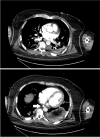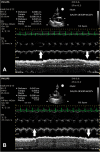Oesophageal balloon positioning by echocardiography to guide positive pressure ventilation
- PMID: 34148202
- PMCID: PMC8214714
- DOI: 10.1007/s10877-021-00730-z
Oesophageal balloon positioning by echocardiography to guide positive pressure ventilation
Abstract
Understanding the respiratory mechanics of ARDS patients is crucial to avoid ventilator-induced lung injury (VILI), and this is much more challenging if not only lung compliance is altered but the whole compliance of the respiratory system is abnormal, as in obese patients. We face this problem daily in the ICU, and to optimize ventilation, we estimate respiratory mechanics using an oesophageal balloon. The balloon position is crucial to assess reliable values. In the present technical note, we describe the use of echocardiography to confirm the correct position of this instrument.
Keywords: ARDS; COVID-19; Chest wall compliance; Oesophageal balloon; Transpulmonary pressure; Ultrasounds.
© 2021. The Author(s).
Conflict of interest statement
The authors declare that they have no conflicts of interest.
Figures




References
Publication types
MeSH terms
LinkOut - more resources
Full Text Sources

